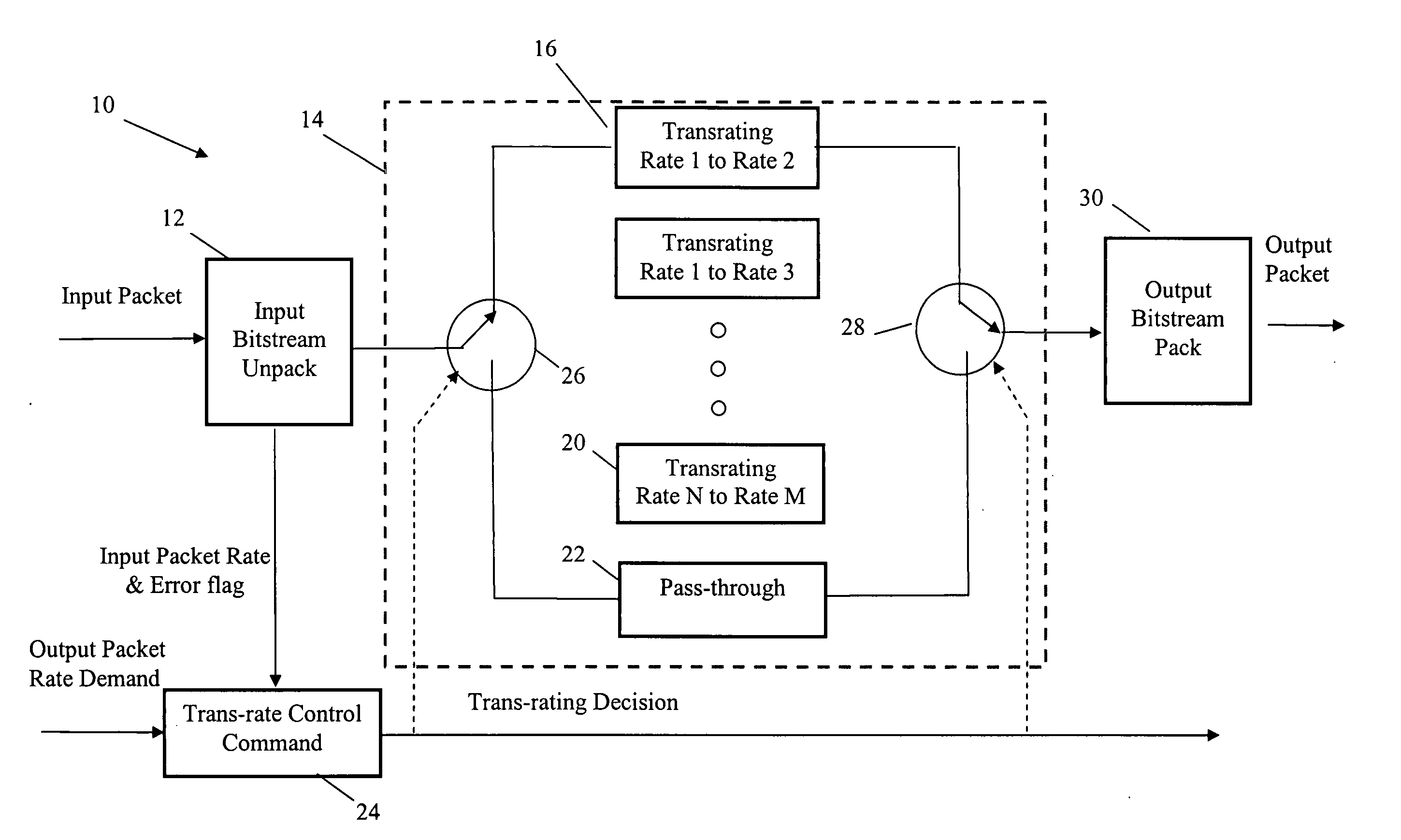Method and apparatus for voice trans-rating in multi-rate voice coders for telecommunications
- Summary
- Abstract
- Description
- Claims
- Application Information
AI Technical Summary
Benefits of technology
Problems solved by technology
Method used
Image
Examples
first embodiment
AMR 5.15 Kbps->4.75 Kbps Trans-Rating
[0077] Examples of suitable systems according to the inventions are now described. A multi-rate voice coder (adaptive multi-rate or AMR, also called GSM-AMR) is taken as an example to show the principle of present invention. The AMR codec uses eight source codecs with bit-rates of 12.2, 10.2, 7.95, 7.40, 6.70, 5.90, 5.15 and 4.75 kbps. FIG. 4 shows the bit allocations of 8 bit-rates in AMR coding algorithm.
[0078] The codec is based on the CODE-EXCITED LINEAR PREDICTIVE (CELP) coding model. A 10th order linear prediction (LP), or short-term, synthesis filter is used. A long-term, or pitch, synthesis filter is implemented using the so-called adaptive codebook approach.
[0079] In the CELP speech synthesis model, the excitation signal at the input of the short-term Linear Prediction (LP) synthesis filter is constructed by adding two excitation vectors from adaptive and fixed (innovative) codebooks. The speech is synthesized by feeding the two prope...
second embodiment
AMR 4.75 Kbps->5.15 Kbps Transraing
[0087]FIG. 15 shows an example of trans-rating an AMR 4.75 kbps bitstream to an AMR 5.15 kbps bitstream according to a second embodiment of present invention. The trans-rating procedure is very similar to that of the opposite direction trans-rating described in the first embodiment. The output codec 5.15 kbps has the same quantization procedures and tables among the LPC coefficients, adaptive codebook parameters, and fixed-codebook parameters. These output unquantized parameters can be obtained directly through the pass-through units in the trans-rating pair.
[0088] The joint gain indices of 4.75 kbps can be obtained from unquantization adaptive codebook gains and fixed-codebook gains of 5.15 kbps through one of the mapping methods among direct-space mapping, analysis in excitation space mapping or analysis in filtered excitation space mapping. FIG. 15 shows an approach based on direct-space mapping.
third embodiment
AMR 12.2 Kbps->4.75 Kbps Transraing
[0089] It is important to note that for AMR 12.2 kbps, LP analysis is performed twice per frame and only once for the other modes down to 4.75 kbps. For the 12.2 kbps mode, the two sets of LP parameters are converted to line spectrum pairs (LSP) and jointly quantized using split matrix quantization (SMQ), 38 bits. For the other modes, the single set of LP parameters is converted to line spectrum pairs (LSP) and vector quantized using split vector quantization (SVQ), 23 bits for 4.75 kbps.
[0090]FIG. 16 shows a block diagram of trans-rating from 12.2 kbps to 4.75 kbps according to a third embodiment of the present invention. The trans-rating pair module selects the method of analysis in filtered excitation space mapping to perform rate conversion.
[0091] First, the indices of LSF parameters are extracted from the incoming 12.2 kbps bitstream, and then the unquantized LSP parameters are obtained through lookup tables and the previous LSP residual ve...
PUM
 Login to View More
Login to View More Abstract
Description
Claims
Application Information
 Login to View More
Login to View More - R&D
- Intellectual Property
- Life Sciences
- Materials
- Tech Scout
- Unparalleled Data Quality
- Higher Quality Content
- 60% Fewer Hallucinations
Browse by: Latest US Patents, China's latest patents, Technical Efficacy Thesaurus, Application Domain, Technology Topic, Popular Technical Reports.
© 2025 PatSnap. All rights reserved.Legal|Privacy policy|Modern Slavery Act Transparency Statement|Sitemap|About US| Contact US: help@patsnap.com



